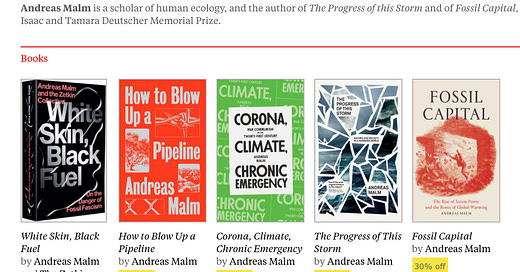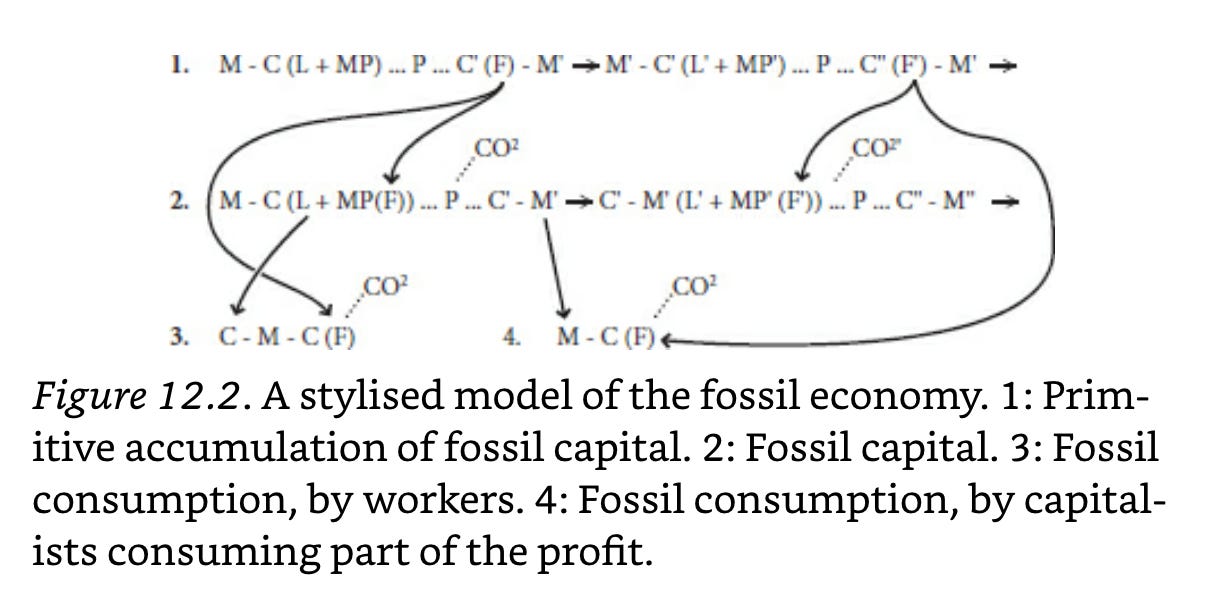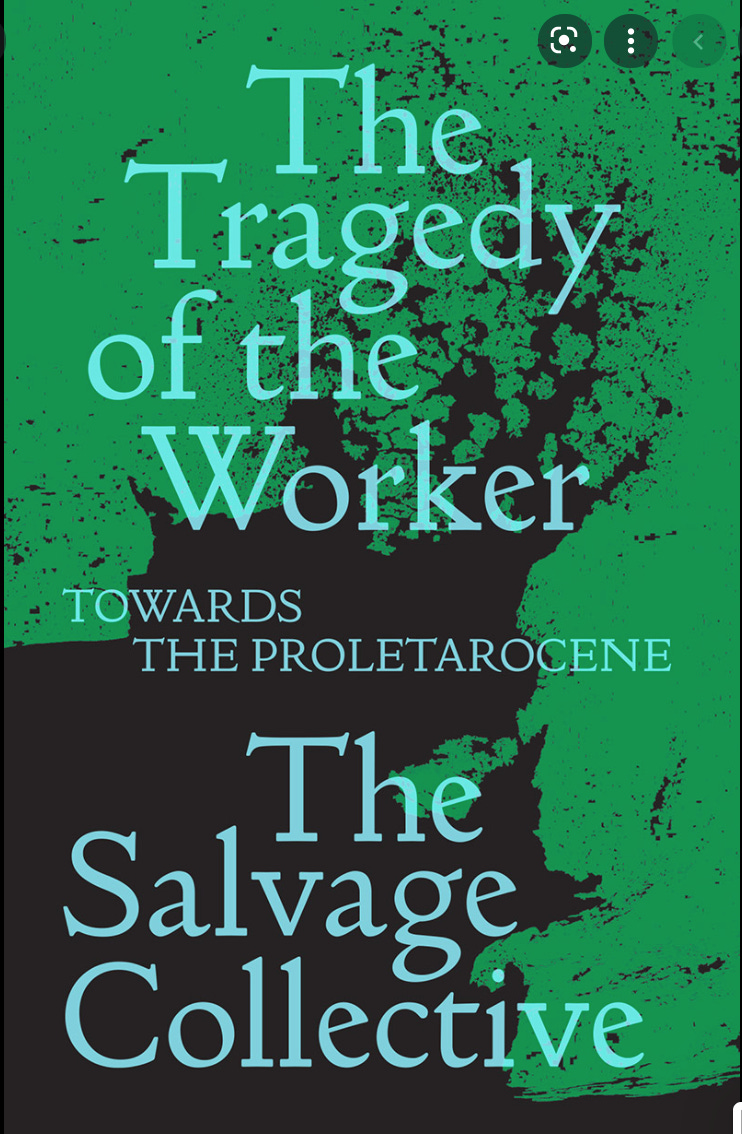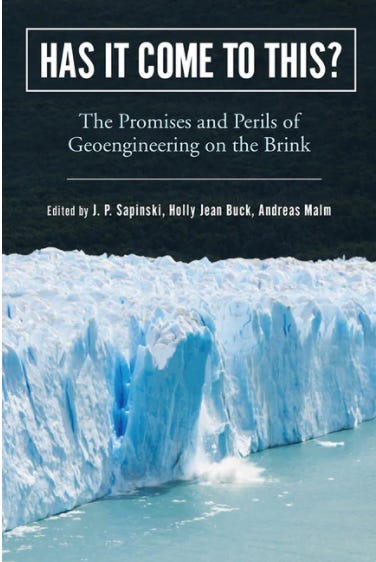In recent weeks I’ve taken a deep dive into the writing of historian and activist Andreas Malm. A long review just appeared in the LRB.
Malm is, simply put, one of the most productive and provocative historical thinkers on the left right now.
Malm can be read in many ways. In my essay I deliberately foreground his interventions as acts of historical interpretation. In particular, in the LRB essay I argue that his most recent writings are efforts to read our current crisis by way of the history of WWI, Russian Revolution and civil war, as compared to the far more comfortable 1940s analogy offered by the Green New Deal.
I was no doubt predisposed to read Malm this way because of my own skepticism about the Green New Deal’s historical references. On this, see my Foreign Policy essay from January 2020.
But this framing of the LRB essay also helped me to distinguish the latest phase of Malm’s work - dated broadly to 2019-2021 - both from his own earlier interventions and other work in Marxist ecology.
**********
Ecological Marxism is a large and multi-stranded school. At its heart is the critique of loose talk about the Anthropocene. The idea of putting humans (Anthropos) at the heart of the story made sense in a natural scientific context. It captures the fact that humans now stand alongside glaciers as movers of the earth's surface. But when transferred from the natural sciences to a more general description of reality, the notion of the anthropocene induces a profound misconception. Though it is true that climate change is human-induced, it is not true that humans in general have that impact. It is the economic system and those who manage and profit from it who do. The epoch of crisis that we are in should really be called the capitalocene.
In the work of many writers in this school, for instance Jason Moore, the notion of the capitalocene takes you back to the early modern period. Malm's historical work to date is distinctive for its focus squarely in the classic Marxian period of the 19th century. His first book Fossil Capital is a directly on the terrain of Kapital volume 1 and Marx’s Grundrisse.
In many environmental histories of capitalism the arrival of the dark satanic mills of 19th-century industrialism is the telos towards the which the whole story develops. It is the place that we know we are going to end up. Malm's pivotal contribution in Fossil Capital lies in throwing open the question of obviousness and delivering a scorching critique of the most familiar explanations for the world-historic shift in the energy system.
In the mainstream that Malm is criticizing there are three predominant views of the coming of the steam-powered factory. Malthusian economic historians (most prominently Tony Wrigley and Ken Pomeranz) argue that by the late 18th century, the European economy was running out of fuel and found an answer to this functional imperative in the form of coal. For other writers, the mastery of steam power is simply the development of humanity's long coevolution with combustion. Managing fire is part of what makes us human. Finally, one can see the advent of steam as first and foremost a technological achievement born out of the scientific revolution and the logic of discovery and enquiry.
Each of these narratives, in its own way, aligns fossil fuel revolution with necessity. For the Malthusians the industrial revolution follows from the imperative need to find ways of overcoming the scarcity of firewood and food. For others it follows from human nature and our drive to mastery. Or, finally, it follows the necessary logic of scientific development.
The problem, according to Malm, is that none of these plausible theories is actually empirically persuasive. Malm argues that through to the mid-nineteenth century, water power was a fully viable economic alternative - both abundant and cheap. To understand what is going on we have to go inside the factory to see how fossil fuels enter as the essential but hitherto unacknowledged complement to the struggle between capital and labour. What was ultimately decisive in Malm’s view was the question of control, or in Marxist terms real rather than formal subsumption. Ultimately, what shaped the technological choices of the British industrialists was the class struggle.
Mobilizing the stock of fossil energy layered under the ground was the weapon with which British capitalists fought back against the upsurge in unionism and Chartism in the 1830s and 1840s. Water was cheap and abundant, but unlike the power unleashed from coal, it could not be controlled. As Malm remarks, "If the autonomy of the working class is to be fought by a regiment of machinery, the prime mover – the field commander – had better be reliable."[1]
Autonomy is the key word here. Though the basic insight of the role of coal is to be found in Marx's Grundrisse, it was Italian Marxists of the so-called autonomist school, struggling in the 1960s and 1970s to make sense of the new abundance of Fordist mass production, who insisted on the fact that technology and class struggle were not separable. As Toni Negri, one of their leaders put it, the basic challenge facing the employer was to subjugate the autonomous potential or Potenza of human labour. The machine was the means for doing so. The classic separation of forces and relations of production was false. In fact the relations of production (as in class struggle) were inside the machinery itself. What Malm adds is the recognition that the driving force of that coercive synthesis is the mobilization of fossil fuels.
Source: Fossil Capital
This isn’t just an imaginative theoretical and historical move. It grounds Malm's skepticism towards the possibilities of reform today. If the relationship between non-renewable one-way exploitation of stocks of energy and the birth of capitalism is not accidental, if it is entangled in the most basic logic of surplus-value-generation, it will be far harder than is commonly imagined to dissociate capitalism from fossil fuels.
Ultimately, a system reliant on the unpredictable flows of natural energy, does not permit the same kind of comprehensive subordination enabled by the unlocking of stocks of coal, oil and gas. It is naïve to imagine that you can simply change the technology and leave the old relations of power and economy in place. In the limit, this would be imply that only comprehensive revolution or a truly coercive state apparatus can impose the energy transition we need.
*******
If Fossil Capital was Malm's opening statement on political economy, the Progress of the Storm begins his turn to the present. It is withering overview of our current intellectual condition. The "storm" of the title is the climate emergency viewed also through the lens of Walter Benjamin's famous meditations in the philosophy of history. And what the angel looks back on is not just the wreckage left by fossil-fueled progress, but a disordered and disorientated intellectual landscape.
The idea that the continued destruction of the environment is enabled by a fog of doubt and confusion is of course all too familiar. Corporate-backed climate denial is perhaps the favorite target of liberal climate activists. Refusal of the logic of climate science is the cardinal sin. But Malm's target here is not simply climate denial, what he identifies is a far more comprehensive loss of intellectual bearings. In the manner of a Marxist cultural critic like György Lukács or a Frederic Jameson, Malm diagnoses an intellectual derangement that affects much of what passes for critical thinking too.
If postmodernity is a malaise of amnesia and displacement – as though time and nature had in fact disappeared – we might think of the warming condition as a realisation, in the dual sense of the term, of a more fundamental illness or wrongness in the world.
Malm, Andreas. The Progress of This Storm . Verso Books. Kindle Edition.
In what is his most aggressive work to date, Malm lays waste to the contemporary intellectual scene. It is an intellectual bloodbath worthy of a Bolshevik bull session. The stakes are far too high for muddy thinking. Malm is there to put things back on their feet.
********
Climate, Corona and Chronic Emergency and White Skin, Black Fuel are historically bookended by these two earlier interventions.
Between Fossil Capital on the classic Marxian terrain of the 19th century and The Progress of This Storm on our current intellectual scene, Malm now inserts Climate, Corona and Chronic Emergency on war communism and White Skin, Black Fuel on the fascist period.
As Barnaby Raine pointed out to me, the “war communism” theme is one that Malm shares with the group of Marxist authors known as the Salvage Collective. Their recent manifesto The Tragedy of the Worker. Towards the Proletarocene begins with the classic lines from the Communist Manifesto:
“Workers of the world unite, you have nothing to lose but your chains. You have a world to win.
But then continues:
What if the world is already lost? This is the question that vexed us as we set out to write The Tragedy of the Worker. From the vantage point of the present, the history of capitalist development is, as Marx expected, the history of the development of a global working class, the proletarianisation of the majority of the world’s population. But the very same process of that development has brought us to the precipice of climate disaster. Our position, position, to recall Trotsky’s rationalisation of War Communism in 1920, is in the highest degree tragic.
It is now clear that we will pass what scientists have long warned will be a tipping point of global warming, accelerating the already catastrophic consequences of capitalist emissions. How do we imagine emancipation on an at best partially habitable planet? Where once communists imagined seizing the means of production, taking the unprecedented capacities of capitalist infrastructures and using them to build a world of plenty, what must we imagine after the apocalypse has befallen us? What does it mean that as capitalism has become truly global, the gravediggers it has created dig not only capitalism’s grave, but also that of much organic life on earth?”
One of the issues at stake here is clearly the need for radical thinking to turn away from the kind of cornucopian promise that was crucial to 19th-century Marxism and has recently been revived by Aaron Bastani in his Fully-Automated Luxury Communism.
For all his visions of communist austerity Malm is anything but a technophobe. He insists that the left must overcome any hang ups about large-scale technology including both nuclear and large-scale carbon capture. On this score, check out:
Has It Come to This? The Promises and Perils of Geoengineering on the Brink.
What is left more open-ended is how far Malm believes that capitalism as such can adjust to a new technological basis.
In light of the foundational analysis in Fossil Capital, it is hard to see how capital accumulation in the form that we know it today can continue without the large-scale harnessing of non-renewable stocks of fossil fuels to the labour process. That, after all, is for Malm, the foundation of profit.
But, if Malm cleaves to this position, it rules out any real compromise with the Green New Deal and reformist camp. In White Skin, Black Fuel, as I indicate in the LRB review, he seems to open the door to compromise. He does so by recognizing a distinction between extractive fossil fuel capitalism i.e. coal, oil and gas extraction, which will have to be wound up, and other forms of business, which may be able to make the energy transition. That would seem to open the door at least to a tactical compromise with those advocating for a Big Green State.
*********
Compared to such subtle shifts in emphasis, the break between How to Blow up a Pipeline and Malm’s earlier work is far more sharp. He is as provocative as ever and as imaginative in the use of historical arguments for current political purposes, but what has gone is the direct reference to the Marxist tradition. This was ruled out constructing a review for the LRB that covered all of Malm’s work to date. I couldnt see a way of bridging the gap and resorted to the historical framing instead.
The intellectual inspiration for the How to Blow Up would seem to be Fanon. In this respect there is a continuity to White Skin. Black Fuel.
But what is missing from How to Blow Up is any reference to Lenin.
It would be tempting to suggest that this is due to Lenin’s disapproval of terrorism. But that is in fact simplistic. As recent scholarship on Lenin has show, though Lenin did not favor individual terrorism, he was far from dismissive of “mass violence” as a revolutionary strategy.
The more obvious reason for Malm’s downplaying of ecological Leninism as a theme in How to Blow Up is the context in which he is intervening. Malm is writing for a specific contemporary context in which extensive references to Lenin would be far from helpful to his cause.
In the LRB piece I frame Malm’s provocative stance in How to Blow Up a Pipeline against the very specific historical situation of the German climate movement between the anti-coal mobilization of Ende Gelände and Fridays for Future. James Butler in his essay on Malm in the same issue adds an excellent panorama of further mobilizations.
For a sense of what was at stake in the German debates, this remarkable dialogue between Malm and Tadzio Müller, one of the organizers of Ende Gelände, is both entertaining and highly instructive.
What is nevertheless striking is the fact that Malm does not engage more systematically with the full range of experience of movements that have sought to combine violent direct action with other forms of political protest. Of course, there are some instances in which this was successful. But there are many others in which this combination of tactics ended in division, isolation and disaster.
Toni Negri who was one of the inspirations for Malm’s early work, paid the price for the disaster of radical militancy in Italy. He spent years in jail and emerged from the “years of lead” scarred and profoundly disillusioned with that form of tactics. In later writing he would diagnose the turn to terrorism as misguided.
Ulrike Meinhof, in fact, does make an appearance in How to Blow up a Pipeline, but only buried in the footnotes. In the text itself she is coyly referred to as "a German journalist" reporting the views of a black radical activist visiting from the US.
Malm no doubt agrees with Negri’s analysis, but he does not give us a more elaborated analysis of what the precise conditions are under which he favors escalation. And, as James Butler suggests, the question must be asked too about the Ende Gelände model that is for Malm the touchstone. It too, after all, ended in failure.
*******
As Malm makes clear in How to Blow up a Pipeline, he refuses to accept historical success and failure as the ultimate criterion of judgement or meaning. After all to do so would write much of the radical tradition out of history. Malm advocates direct action in part as a tonic to the demoralization that results from living in the cognitive dissonance of climate capitalism. And he recommends it on the basis of personal experience. As he describes his involvement in the 2016 Ende Gelände action:
"If destroying fences was an act of violence, it was violence of the sweetest kind. I was high for weeks afterwards. All the despair that climate breakdown generates on a daily basis was out of my system, if only temporarily: I had had an injection of collective empowerment. There is a famous line in Wretched of the Earth where Frantz fanon writes of violence as a "cleansing force". It frees the native "from his despair and inaction; it makes him fearless and restores his self-respect." … there has been a time for Gandhian climate movement; perhaps there might come a time for a Fanonian one."
In How to Blow up a Pipeline the ultimate touchstone of significance for Malm is, at least on my reading, the heroic resistance of Jewish fighters against Nazi extermination policy. This takes up several dramatic paragraphs in the book.
It struck me this way no doubt in part because I am particularly sensitized to historical references to World War II and the Third Reich. I had written about Vasily Grossman’s definition of freedom in relation to death only a few months earlier, in Chartbook #21.
And I emphasizes Malm’s references to the Jewish resistance Nazism, also as a way to anchor How to Blow up a Pipeline in the same historical conjuncture as War Communism and fascism. Ultimately, on the reading offered in my LRB essay, it is that shared historical imaginary that links Malm’s three most recent interventions as a single unit and counterposes them against the more optimistic Anglo-American Green New Deal framing. Historical imagination bridges the theoretical discontinuities to Malm’s earlier work.
There is, however, also another anchor for Malm’s vision of historically meaningful, if unavailing struggle and that is the ongoing Palestinian resistance. Malm spells out the connection in a remarkable essay for Salvage in 2017.
Not only is Palestinian history an allegory for the kind of displacement that much of the world’s population may suffer over the next century, if the climate crisis is not contained. There is also an interconnected material history of power, colonialism and fossil fuels, by way of the history of fossil-fueled Western power in the region, Middle East oil and the pipelines that channel it to Western markets.
*******
Malm’s work is instructive, brilliant and unsettling.
His historical imagination is fascinating and inspiring.
His arguments pose a serious intellectual challenge to complacent reformism.
The extent to which they become an actual political challenge will depend on the degree of reformism’s success in delivering real progress on the energy transition.
That is the historical test that can no longer be dodged.







